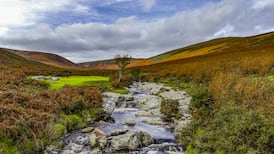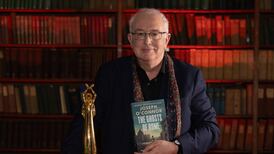I almost mistook these busy butterflies for sweet pea flowers, as this was where I found them in our garden! Denise Keating, Co Waterford
Oh, they are busy all right, ensuring the existence of the next generation. This is a mating pair of large white butterflies with the black-tipped forewing of the male on display, while the undersides of the female’s wings are evident. They may be choosing your lovely fragrant sweet peas for their mating boudoir, but the female will lay on your cabbages and nasturtiums – and the emerging caterpillars will make short work of them.

Is this a wood pigeon resting after feeding on the apples here at St Joseph’s Hospital in Ennis? It was resting there for a long time. Enda Scanlon, Co Clare
It is a wood pigeon – the white neck patch and the white crescents on the edge of its wings are the distinguishing features. These birds are entirely vegetarian and feed on leaves, fruit and indeed newly emerging vegetables growing in the garden. They feed their young on a milk derived from their vegetarian diet, which comes from fluid-filled cells in the lining of their crop.
RM Block

I rescued this guy from a mouse trap. It looks like a shrew but has a lot of hair. Frank Curran, Co Kildare
It’s not hair – it’s fur. The poor thing must have been in very humid conditions in the mouse trap for it to be so wet and flattened. We have two species of shrew in Ireland. This appears to be the larger (white-toothed) shrew, which is outcompeting our native pygmy shrew since it was accidentally introduced here. That was believed to be about 2004, though it was only first noticed in 2007 in barn owl and kestrel pellets.

I recently heard a discussion on radio about hummingbirds, which informed me that while we don’t have these birds in Ireland, we do have hummingbird hawkmoths. I had never seen one here in Ireland but to my amazement I saw what I think is this beautiful moth feeding off Buddleia flowers in my garden that very afternoon. What a coincidence! Noreen Ryan, Galway
Well done on your excellent photo of a hummingbird hawkmoth – Macroglossum stellatarum – in full feeding mode. This is a day-flying migrant moth, which visits us in Ireland from continental Europe during warm summers. Buddleia is a favourite feeding plant. It hovers in front of the flower, beating its wings 80 times a second, which produces an audible hum. It extends its long proboscis or “tongue” and drinks the nectar from the shallow flowers. Some make the return journey in the autumn. They also may well be overwintering as adults here in Ireland, according to the National Biodiversity Data Centre, as our winters become warmer. Caterpillars feed on lady’s bedstraw and wild madder, so this is another reason to let wildflowers bloom.

I found this growing in the gravel outside our house. I have never seen it before, and a quick internet search suggests it is buckwheat (Fagopyrum esculentum). Am I correct? I throw birdseed there during the winter, so that possibly could be the source. John Doyle, Cork
Yes, both you and the internet are correct. Buckwheat is a rare casual plant in Ireland and usually found as a remnant of former cultivation. It is not a member of the grass family, as is wheat and other cereals, but belongs to the knotgrass family and is grown in northern latitudes for its edible seeds, which are used to make flour for blinis. It is also a component of bird seed mixes, so you probably planted it yourself.
Please submit your nature query, observation, or photo, with a location, via irishtimes.com/eyeonnature or by email to weekend@irishtimes.com





















